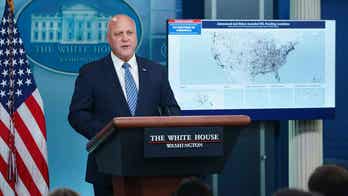
January 25, 2012: U.S. First Lady Michelle Obama joins the lunch line at Parklawn Elementary School in Alexandria, Virginia. Obama made the visit to speak about the United States Department of Agriculture's (USDA) new and improved nutrition standards for school lunches. (REUTERS/Kevin Lamarque )
The healthy school lunch program championed by former first lady Michelle Obama has had its fair share of criticism -- but with a new administration in place, the program could be rolled back.
A document released by the office of Rep. Mark Meadows, R-N.C., called for repealing certain aspects of the Healthy Hunger-Free Kids Act of 2010 – the legislation that helped put Michelle Obama’s hallmark program into law. The initiative is part of a broader plan released by Meadows titled, “First 100 Days: Rules, Regulations, and Executive Orders to Examine, Revoke and Issue.”
The document calls for the Trump administration to reverse nearly 200 rules and regulations, including the requirements of the 2010 law.
“The regulations have proven to be burdensome and unworkable for schools to implement,” reads a related report from the House Freedom Caucus, of which Meadows is a member. “Schools are throwing food away that students are not eating.”
Since 2012, the U.S. Department of Agriculture has implemented the requirement – tied to the 2010 law – that schools include either a fruit or vegetable for lunches subsidized by the federal government. However, a report published in August 2015 by researchers at the University of Vermont found even though students added more fruits and vegetables to their plates, “children consumed fewer [fruits and vegetables] and wasted more during the school year immediately following implementation of the USDA rule.”
Titled “Impact of the National School Lunch Program on Fruit and Vegetable Selection,” the report noted that average waste increased from a quarter cup to more than one-third of a cup per tray. Observing students at two northeastern elementary schools during more than 20 visits to each, researchers took photos of students’ trays after they chose their items, as they were exiting the lunch line and again as they went by the garbage cans.
Had a very #healthylunch today. The apple definitely made up for the "mystery mush" #ThanksMichelleObama pic.twitter.com/RWCnQRCxJK
— Hunter Whitney (@huntwhitney4) November 13, 2014
The study's conclusions comport with widespread complaints from school officials and parents that the program encourages food waste. It also has drawn criticism for cost, implementation difficulties and unpopularity with students.
Further, since the restrictions on calories, fat, sugar, sodium, whole grains, fruits and vegetables went into effect, it is estimated that over 1.2 million students have stopped eating school lunches, according to EAGnews.org. School systems also dropped out of the program because it led in some cases to compliance costs exceeding the amount of federal subsidies received.
This is my lunch. I'm in high school. #ThanksMichelleObama pic.twitter.com/02t4MScBIe
— Maya (@mayawuertz) November 17, 2014
According the education news site, some schools had to get creative in disposing of the food waste, feeding leftovers to pigs and other animals at nearby farms.
There have been positive results from the Healthy Hunger-Free Kids Act.
According to the Christian Science Monitor, a report was released earlier this month in the medical journal JAMA Pediatrics in which researchers from the University of Washington Nutritional Sciences Program concluded the standards had a substantial impact on the quality of food provided at schools.
The researchers looked at the nutritional value of nearly 2 million meals selected by 7,200 students in several middle and high schools in an urban school district in Washington state. The scientists compared data collected in the 16 months before the standards were carried out with data from the 15 months after the standards were put in place -- and found an increase in six nutrients: calcium, vitamin C, vitamin A, iron, fiber, and protein.




